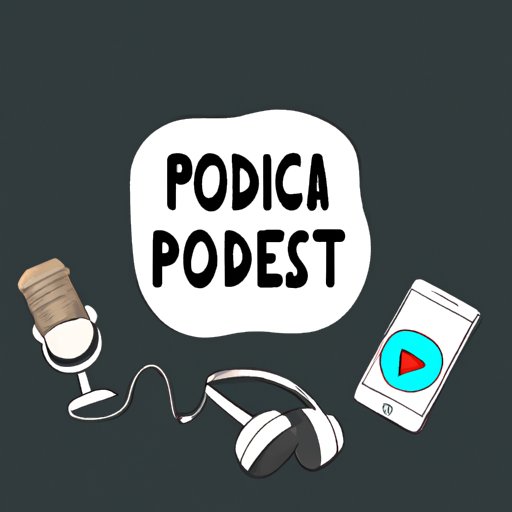Introduction
A podcast is an audio file that can be downloaded or streamed over the internet. It’s similar to a radio show but it can be listened to anytime, anywhere. In recent years, podcasts have become increasingly popular as more people turn to them for entertainment, education, and information. If you’re looking to start your own podcast, this comprehensive guide will provide you with the resources and steps you need to make it happen.
What is a Podcast?
A podcast is an audio program that can be accessed through the internet. It can include conversations, interviews, lectures, music, stories, and more. Podcasts are usually part of a larger series, and many of them are released on a regular schedule. People often listen to podcasts when they’re commuting, exercising, or just relaxing at home.
Benefits of Starting a Podcast
There are numerous benefits to starting a podcast. For one, it’s a great way to reach a wide audience. You can easily share your podcast on social media and other platforms, allowing your content to reach people all over the world. Additionally, podcasts are relatively inexpensive to produce and maintain, making them a great option for those on a budget. Finally, podcasts offer the opportunity to build relationships with your listeners. By engaging with your audience and responding to their questions and comments, you can create a community around your podcast.
Research Your Topic and Target Audience
Before you dive into creating your podcast, it’s important to do some research. First, you should identify your target audience. Who do you want to reach with your podcast? Knowing your target audience will help you decide what topics to cover and how to best engage with your listeners. Once you know who you’re targeting, you can select a topic for your podcast. Be sure to analyze the competition in your chosen niche. What topics are already being covered? How can you stand out from the competition?
Develop a Content Plan and Format
Once you’ve identified your target audience and topic, it’s time to develop a content plan. Break down your content plan into episodes and decide on the format of each episode. Will you have one guest per episode or multiple? Will you have a specific segment or segments? Will you have a call-in component? Once you’ve decided on the format, choose topics for each episode. Doing this ahead of time will help you stay organized and on track with your podcast.

Choose the Right Equipment and Software
When it comes to recording your podcast, it’s important to invest in the right equipment and software. The most important piece of equipment is a good microphone. To ensure quality sound, look for a microphone with a good frequency range, low noise floor, and good clarity. You’ll also need recording software. Popular options include Adobe Audition, GarageBand, and Audacity. Consider other equipment and accessories such as pop filters, shock mounts, and headphones.
Record, Edit, and Upload Your Episodes
Once you have all the necessary equipment, it’s time to record your episodes. Before you begin, prepare yourself by doing a practice run and familiarizing yourself with the equipment. When you’re ready, record your episode. After you’ve finished recording, edit your audio files and upload them to your hosting platform. Popular hosting platforms include Libsyn, Podbean, and Spreaker.

Promote Your Podcast on Social Media
Now that your podcast is up and running, it’s time to promote it. Create social media accounts for your podcast and post regularly. Engage with your followers and answer any questions they may have. Leverage influencer marketing by connecting with influencers in your niche. Ask them to share your podcast with their followers and review your podcast on their platforms.

Analyze Your Podcast Performance Metrics
As your podcast grows, it’s important to track and monitor your performance. Track your downloads and listens to see how many people are tuning in. Monitor listener engagement to see which episodes are resonating the most with your audience. Assess your performance and use the data to inform future decisions about your podcast.
Conclusion
Starting a podcast can be a rewarding experience. From researching your topic and target audience to recording and promoting your podcast, there’s a lot to consider. However, if you follow the steps outlined in this comprehensive guide, you’ll be well on your way to launching a successful podcast.
(Note: Is this article not meeting your expectations? Do you have knowledge or insights to share? Unlock new opportunities and expand your reach by joining our authors team. Click Registration to join us and share your expertise with our readers.)
